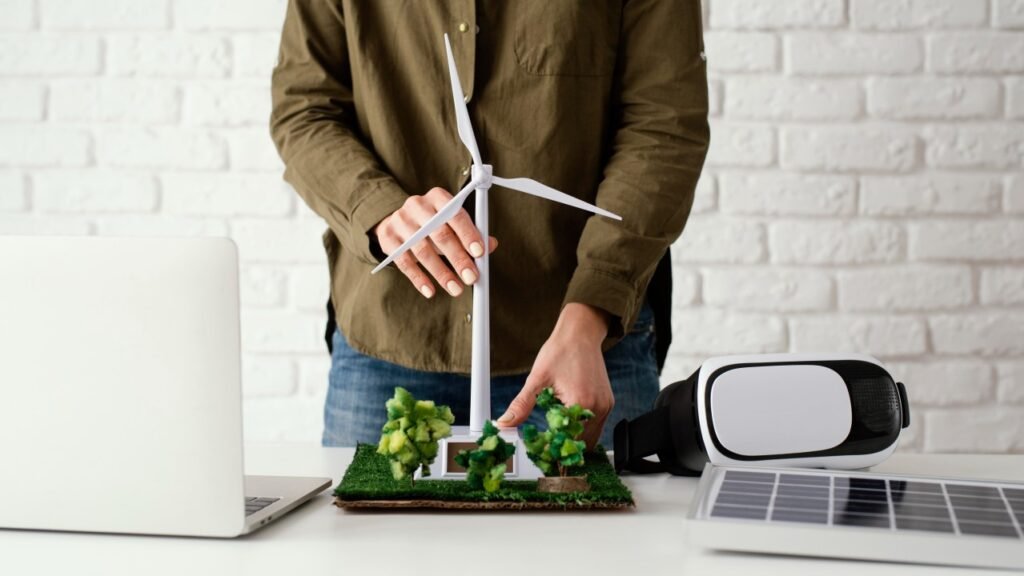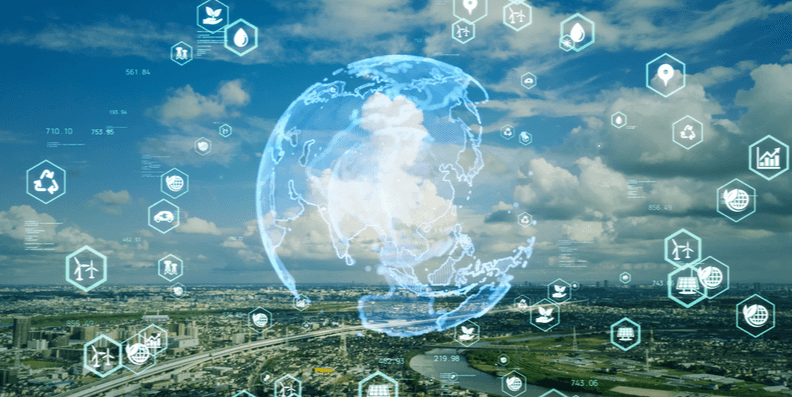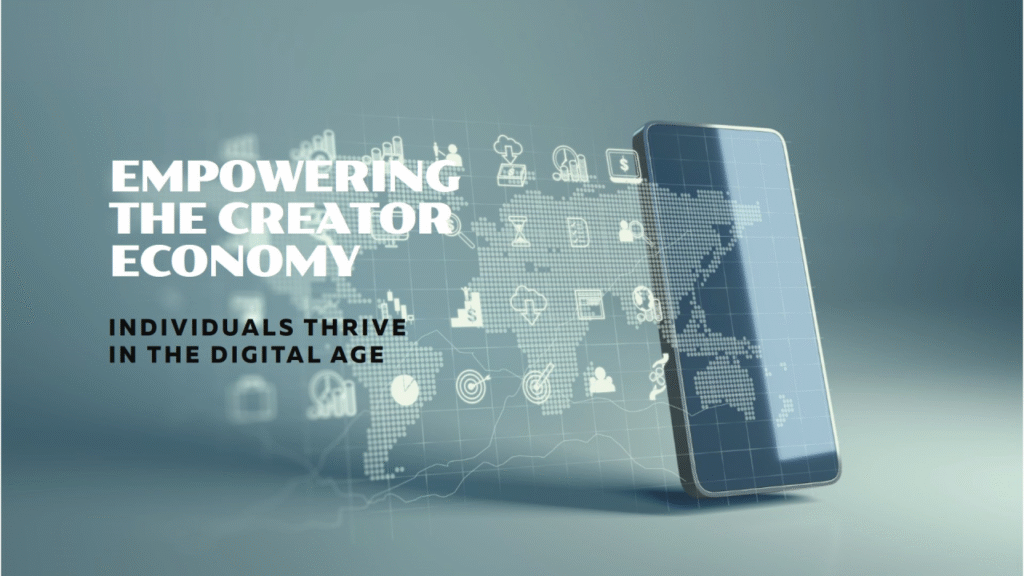The business landscape in 2025 is witnessing a revolutionary transformation — where
technology, sustainability, and human creativity are driving a new wave of growth. From
AI-powered strategies to eco-conscious entrepreneurship, this is the era where agility
defines success and innovation fuels expansion.
Let’s dive into some of the defining shifts shaping the future of global startups and
enterprises. �
Remote Work 2.0 – Is Hybrid Work the
Future?

Introduction: The Evolution of Work
The global work environment has witnessed one of the most dramatic
transformations in modern history. Before 2020, remote work was often
viewed as a rare perk, offered mainly by progressive startups or
technology-driven companies. Traditional businesses still believed in the
necessity of physical presence, structured office hours, and face-to-face
collaboration.
Then came the COVID-19 pandemic, which forced organizations to rethink
everything they knew about productivity, collaboration, and the workplace
itself. Millions of employees shifted overnight from bustling offices to their
dining tables and home offices, proving that business continuity was possible
outside traditional spaces.
What started as a crisis response has since evolved into a deliberate strategy:
Remote Work 2.0 — a balanced, hybrid work model that combines the
flexibility of remote work with the human connection and collaborative energy
of in-office settings. This hybrid future is no longer about survival. It’s about
building sustainable systems that enhance productivity, support employee
well-being, and unlock operational efficiency at scale.
Adoption by Industry Leaders
When discussing hybrid work adoption, the role of industry giants cannot be
overstated. Organizations such as Google, Microsoft, Infosys, and
Accenture are not only experimenting but actively setting benchmarks for
others to follow.
● Flexi-office models: Employees are no longer bound to rigid 9-to-5
office schedules. Instead, they can choose how to split their workweek
between home and the office. This ensures that while individuals enjoy
flexibility, the company can still facilitate in-person collaboration for
crucial activities like brainstorming sessions, product launches, or client
negotiations.
● Workplace reimagination: Offices are being restructured from rows of
desks into collaborative hubs. Instead of housing employees five days
a week, they are evolving into innovation spaces where teams gather
intentionally to ideate, connect, and create.
● Policy frameworks: These corporations have developed policies
around hybrid arrangements that prioritize inclusivity, equity, and
fairness. For example, ensuring remote employees have access to the
same opportunities as those working in the office.
By redefining workplace norms, these leaders are shaping the expectations of
the global workforce. Employees increasingly view hybrid work not as a
privilege, but as a standard.
2019 – 15% Adoption
Before the pandemic, remote work was still a niche practice. Only about
15% of companies offered flexible or hybrid setups, and these were largely
limited to tech-forward organizations or companies operating in global
markets. The majority of traditional industries, from manufacturing to finance,
still relied on physical presence. Remote work was viewed as an exception,
often reserved for senior employees or special cases.
2021 – 48% Adoption
The pandemic acted as a catalyst for change. Practically overnight,
organizations worldwide had to adopt remote work to ensure business
continuity. By 2021, nearly half of all organizations (48%) had some form of
remote or hybrid arrangement in place.
This shift accelerated digital transformation: companies invested in cloud
infrastructure, virtual communication platforms, cybersecurity
frameworks, and employee monitoring systems. Suddenly, what was once
considered “impossible” became the norm. Importantly, it also changed
employee expectations — flexibility was no longer a perk but a requirement
for retention.
2025 – 73% Projected Adoption
Looking forward, remote and hybrid work are set to become dominant models.
By 2025, 73% of organizations worldwide are expected to embrace
hybrid setups.
This projection reflects a deeper recognition: hybrid work is not just a
temporary adjustment but a strategic advantage. Companies anticipate
tangible benefits such as:
● Improved employee satisfaction leading to higher retention rates.
● Productivity gains due to reduced commuting and greater focus.
● Operational efficiency through optimized office space and reduced
overheads.
Hybrid work is poised to become a cornerstone of modern workplace
culture, shaping how organizations attract talent, structure teams, and define
success.
Challenges & Considerations
While hybrid work offers immense potential, it is not without challenges:
● Equity of opportunities: Remote employees risk being overlooked for
promotions or key assignments compared to in-office counterparts.
● Cultural cohesion: Building a strong, unified workplace culture is
harder when teams are distributed.
● Cybersecurity risks: Remote work increases vulnerabilities, requiring
robust digital security frameworks.
● Burnout & boundaries: Without clear boundaries, employees often
face difficulty separating work from personal life.
For Remote Work 2.0 to succeed, companies must address these concerns
proactively through inclusive policies, regular communication, and investment
in employee well-being.
Conclusion: The Future is Hybrid
The journey from the emergency shift of 2020 to the refined hybrid models of
2025 reveals a profound truth: work will never go back to pre-pandemic
norms.
Remote Work 2.0 — the hybrid model — is here to stay, not as a compromise
but as a superior approach to balancing productivity, collaboration, and
human well-being. It empowers employees with flexibility, enables
organizations to cut costs and scale globally, and ensures that in-person
collaboration is preserved where it matters most.
By 2025, with nearly three-quarters of organizations adopting hybrid setups,
we will likely look back on the pandemic as the turning point that redefined
work forever. Far from losing momentum, hybrid work is becoming the new
global standard — the future of work itself.
Green Tech Startups – Building a
Sustainable Future

Introduction: The Rise of Green Innovation
The global conversation around climate change, resource depletion, and
environmental degradation has reached a tipping point. From governments to
consumers, there is an urgent demand for solutions that not only reduce harm
to the planet but also reimagine how businesses operate in a sustainable way.
Enter Green Tech startups — young, agile companies that are reshaping
industries by embedding sustainability at the heart of innovation. Unlike
traditional corporations that often retrofit eco-friendly measures into existing
systems, these startups are born green. Their very business models are
designed around renewable energy, resource efficiency, waste reduction, and
carbon neutrality.
The emergence of this ecosystem marks a turning point in business history.
Sustainability is no longer a separate vertical or corporate responsibility
program — it is becoming the foundation of economic growth,
competitiveness, and global relevance.
Sustainability as a Business Imperative
In today’s fast-changing economy, sustainability has shifted from being a
“good-to-have” to a business necessity. Organizations across industries are
realizing that their long-term survival depends on their ability to align with
environmental responsibility.
● Direct impact on growth: Companies that reduce their carbon
footprint, adopt renewable energy, and embrace circular economy
practices are not only contributing to the planet but also cutting costs,
improving efficiency, and accessing new markets.
● Consumer-driven pressure: Modern consumers — particularly
millennials and Gen Z — are increasingly drawn to brands that
demonstrate authentic commitment to sustainability. Eco-conscious
buyers often prefer green products, even if they come at a premium,
creating new demand streams.
● Investor influence: ESG (Environmental, Social, and Governance)
criteria are becoming central to investment decisions. Venture
capitalists and institutional investors are directing funds toward
companies that prove they can balance profitability with planet-friendly
impact.
● Operational transformation: Sustainability is influencing supply
chains, product design, marketing strategies, and even HR
policies. For example, companies are shifting to biodegradable
packaging, sourcing responsibly, and using AI to monitor and reduce
emissions.
In short, sustainability is not a corporate responsibility checklist — it is a
strategic blueprint for future competitiveness. Businesses that fail to adapt
risk not only reputational damage but also financial decline as global
regulations tighten and consumer preferences shift.
Pioneering Startups Leading the Way

The most exciting development in the sustainability landscape is the rise of
Green Tech startups. These ventures are not waiting for incremental policy
changes or corporate adjustments — they are proactively designing and
scaling innovations that directly address environmental challenges.
🌍 BluSmart Mobility
As India’s first all-electric ride-hailing platform, BluSmart is revolutionizing
urban transport. In a country where air pollution is one of the leading health
risks, BluSmart’s model demonstrates how mobility can be reimagined:
● 100% electric fleet powered by renewable energy.
● EV charging infrastructure developed alongside mobility services,
solving one of the biggest bottlenecks for EV adoption.
● Reduced carbon footprint by eliminating fossil fuel use and lowering
noise pollution.
BluSmart isn’t just offering an alternative to traditional taxis — it is building a
blueprint for sustainable urban mobility ecosystems that smart cities
worldwide can replicate.
⚡ ReNew Power
As one of India’s largest renewable energy producers, ReNew Power is
proving that clean energy can be both scalable and profitable. Its work spans
wind, solar, and hydro projects, supplying electricity to millions while
displacing coal dependency.
Key highlights:
● Operates utility-scale renewable projects across India.
● Directly aligns with national and global climate goals.
● Demonstrates commercial viability of renewables in energy-hungry
markets.
ReNew shows that renewable energy isn’t just an ethical choice — it’s a
smart economic bet. By providing green power at competitive prices, it is
redefining how energy grids of the future will function.
🌬 Atomberg Technologies
Where BluSmart and ReNew address mobility and energy, Atomberg focuses
on everyday efficiency. Its BLDC motor-powered fans use up to 65% less
electricity than conventional models — a small change with massive impact
when scaled across millions of households and offices.
Atomberg’s philosophy:
● Every watt saved counts.
● Smart, connected appliances should not only offer convenience but also
reduce long-term energy demand.
● Consumer-focused Green Tech can achieve rapid adoption when it
aligns with cost savings and usability.
Atomberg highlights how sustainable innovation can be seamlessly
integrated into daily life while offering tangible benefits to users.
The Business Case for Eco-Conscious Innovation

What unites startups like BluSmart, ReNew, and Atomberg is the realization
that sustainability and profitability are not mutually exclusive. In fact, they
reinforce one another.
● Revenue opportunities: Green Tech solutions often open up entirely
new markets, from EV charging stations to eco-friendly appliances.
● Investor appeal: Startups with clear sustainability goals attract funding
more easily, as global capital seeks to align with ESG values.
● Scalability: Green innovations that solve real problems — such as
energy shortages, pollution, or rising fuel costs — are inherently
scalable.
Eco-conscious innovation is no longer “niche.” It is becoming the mainstream
path for growth and investment, proving that doing good for the planet can
also mean doing well financially.
4.Investor Confidence & Funding Trends
Green Tech startups are now magnets for investors. According to global
funding data, Green Tech investment surpassed $40 billion in 2024,
making it one of the fastest-growing sectors in venture capital.
● Why investors are betting big:
○ Rising global climate commitments (Paris Agreement, COP
pledges).
○ Increasing demand for ESG-compliant portfolios.
○ Long-term profitability of sustainable solutions.
● Types of investors entering the space:
○ Venture capital firms backing early-stage startups with
disruptive ideas.
○ Institutional investors looking for sustainable long-term assets.
○ Corporate venture arms of large companies aiming to integrate
startups into their sustainability goals.
The surge in investor interest shows a critical shift: sustainability is no longer
seen as charity, but as the future of profitable business ecosystems.
📈 Growth Scope: The Future of Green Tech

The Green Tech startup ecosystem is expected to grow at a CAGR of
25%, driven by several converging forces:
● Corporate ESG commitments: Multinational corporations are setting
ambitious sustainability targets, creating demand for innovative
solutions.
● Consumer awareness: Shoppers are increasingly prioritizing
eco-friendly products and rewarding brands with authentic green values.
● Policy support: Governments are incentivizing renewable adoption,
penalizing polluters, and funding sustainable infrastructure.
● Continuous innovation: Advancements in solar tech, battery storage,
AI-driven energy efficiency, and waste management will push the sector
forward.
This growth signals a profound truth: Green Tech is no longer a niche
category — it is a mainstream economic driver. It will shape not only
energy and mobility but also manufacturing, consumer goods, agriculture, and
digital infrastructure.
Conclusion: A Sustainable Future Built by Startups
The journey of Green Tech startups shows that sustainability and
innovation are converging to create the foundation of the future economy.
● Startups like BluSmart, ReNew, and Atomberg are pioneering models
that combine environmental stewardship with profitability.
● Investors are backing these solutions with billions, recognizing their
long-term economic potential.
● Consumers and corporations alike are demanding eco-friendly products
and practices, accelerating adoption.
Ultimately, Green Tech startups are not just solving environmental problems —
they are reshaping how economies grow, how societies consume, and
how industries operate.
The message is clear: in the global economy of tomorrow, the greenest
companies will also be the strongest companies.
Investor Confidence & Funding Trends in
Green Tech

Introduction – The Emergence of Green Tech as an
Investment Magnet
The global economy is undergoing a profound transformation where
sustainability is no longer a secondary consideration but a defining principle
for growth. At the heart of this change lies the rise of Green Technology
(Green Tech) startups, which are pioneering solutions to tackle climate
change, renewable energy adoption, waste management, and carbon
neutrality. Once considered risky and experimental, these ventures have now
become prime opportunities for investors seeking both financial returns and
long-term environmental impact.
Over the past decade, the narrative has shifted from skepticism to confidence.
Where investors once questioned the scalability of clean technologies, they
now see Green Tech as a cornerstone of the future economy. As global
awareness of the climate crisis deepens, and as governments introduce
stricter sustainability regulations, investor sentiment has shifted dramatically.
Today, backing Green Tech is not just a matter of ethics or corporate
responsibility—it is a matter of economic survival and growth.
Surging Investment Volumes – A Multi-Billion Dollar
Industry
By 2024, global Green Tech funding surpassed an extraordinary $40 billion
milestone, demonstrating not only the pace of growth but also the scale of
investor conviction. What makes this figure particularly significant is the
diversity of funding sources. The investment influx is no longer limited to niche
environmental funds; mainstream venture capital firms, private equity houses,
sovereign wealth funds, and even traditional banks are pouring capital into this
sector.
This is not a fleeting phenomenon but part of a structural shift in the global
financial ecosystem. Policymakers worldwide are creating incentives for
sustainable practices, such as tax breaks for renewable energy projects,
carbon trading systems, and ESG (Environmental, Social, and Governance)
disclosure mandates. As a result, investors now see Green Tech startups as
ventures aligned not only with environmental goals but also with
policy-driven financial benefits.
Investor Motivations – Why Capital is Flowing into
Green Tech
Several interconnected factors explain why investor confidence is at an
all-time high:
- Dual Returns – Profit and Purpose
Unlike traditional sectors, Green Tech offers a dual value proposition:
financial profitability and measurable environmental impact. For modern
investors, especially millennials and institutional funds bound by ESG
mandates, this combination is irresistible. - Regulatory Push & Policy Alignment
Governments across Europe, North America, and Asia are rolling out
carbon-neutrality roadmaps. Policies like the European Green Deal,
India’s renewable energy targets, and the U.S. Inflation Reduction Act
are creating fertile grounds for startups that align with these mandates.
Investors are eager to ride this wave of policy support. - Long-Term Risk Mitigation
Businesses that fail to integrate sustainability are at risk of losing
relevance, facing regulatory penalties, or suffering reputational damage.
Green Tech startups, on the other hand, are positioned as future-proof
investments that hedge against these risks. - Shifting Market Dynamics
Consumers are driving demand for eco-friendly solutions—from electric
vehicles and plant-based foods to green packaging and clean energy.
Investors are channeling capital into startups that can meet this demand
and capture market share.
Growth Scope – The Next Frontier of Green Tech
Funding

Market analysts project the Green Tech startup ecosystem to grow at an
extraordinary compound annual growth rate (CAGR) of 25% from 2024 to
This trajectory signals that Green Tech is not merely a trend but an unstoppable transformation in how industries function and economies grow.
Key Forces Driving This Growth
- Rising ESG Commitments
Multinational corporations and governments are embedding ESG into
the very fabric of their operations. Carbon-neutrality pledges, renewable
adoption deadlines, and strict reporting mandates are pushing demand
for startups that can deliver scalable impact. For example, Fortune 500
companies are partnering with energy-tech firms to reduce emissions in
their supply chains, creating new opportunities for innovative ventures. - Consumer Behavior Shifts
Today’s consumers are deeply aware of their ecological footprint.
Surveys reveal that 72% of millennials prefer sustainable brands
and are willing to pay a premium for eco-conscious products. This
consumer shift has turned sustainability from a niche selling point into a
mainstream market expectation, accelerating adoption of green
technologies across sectors like transportation, agriculture, fashion, and
real estate. - Technological Breakthroughs
Advancements in AI, IoT, and blockchain are intersecting with Green
Tech to create scalable solutions. Smart grids, precision agriculture,
carbon capture systems, and next-generation recycling technologies are
attracting significant investment because they address both market
inefficiencies and environmental needs. - Financial Ecosystem Support
Impact funds, climate-focused venture capital firms, and green bonds
are creating a robust financial infrastructure for startups. This ensures that even early-stage companies with breakthrough ideas have access to growth capital.
Case Studies – Investor-Backed Success Stories
- Tesla – Once a risky bet, Tesla has become the poster child of Green
Tech investment success. Its evolution from an ambitious EV startup
to a trillion-dollar company has proven that sustainability-focused
businesses can achieve massive scale. - ReNew Power (India) – Backed by global investors, ReNew Power has
emerged as one of the largest renewable energy companies in Asia,
demonstrating how institutional capital can transform national energy
grids. - Northvolt (Sweden) – Supported by both private investors and the
European Investment Bank, Northvolt is building sustainable battery
infrastructure in Europe, proving that large-scale Green Tech projects
can attract multi-billion-dollar commitments.
Implications for the Future – Beyond Returns

The implications of this surge in funding extend far beyond financial metrics:
● Job Creation: The Green Tech revolution is expected to generate
millions of new jobs in renewable energy, sustainable agriculture, waste
management, and green construction.
● Innovation Ecosystem: As funding grows, startups will be able to
invest more in R&D, fueling innovation cycles that deliver
next-generation technologies.
● Global Collaboration: Cross-border investment deals are fostering a
global ecosystem where ideas and solutions flow seamlessly across
markets.
● Resilient Economies: By reducing dependence on fossil fuels and
unsustainable practices, economies investing in Green Tech will
become more resilient to climate shocks and supply chain disruptions.
Conclusion – A Greener, Wealthier Tomorrow
Green Tech startups have transitioned from being perceived as high-risk,
low-reward ventures to high-growth engines that are reshaping the global
economy. Investor confidence is no longer tentative—it is robust, structured,
and backed by billions of dollars in funding. The convergence of consumer
demand, policy incentives, ESG commitments, and technological innovation
has positioned Green Tech as one of the most promising sectors of the 21st
century.
As capital continues to flow in, the future will belong to those ventures that
successfully combine profitability with planet-saving innovation. Simply put,
investing in Green Tech today is not just about financial returns—it is
about securing a sustainable future for generations to come.
Creator Economy in 2025 – Empowering
Individuals

Introduction: The Rise of Solo Entrepreneurship
The global work culture is undergoing a fundamental shift. Traditional career paths and
corporate hierarchies are no longer the only gateways to success. Welcome to the age of
solo entrepreneurship, where individuals have the tools, platforms, and audience to build
careers independently.
This new wave is powered by the creator economy — a system where individuals monetize
their skills, content, and personal brands directly through digital platforms. Unlike
conventional business models, the creator economy allows people to bypass intermediaries,
giving them control over their work, audience, and income streams.
By 2027, this market is projected to reach $500 billion globally, making it one of the
fastest-growing ecosystems in the digital era.
2.Defining the Creator Economy
At its core, the creator economy refers to the network of independent content creators,
curators, educators, influencers, and entrepreneurs who use digital platforms to reach
audiences and monetize their work.
Creators can earn in multiple ways:
● Content Monetization: Advertising revenue on YouTube, TikTok, Instagram, or
podcasts.
● Subscriptions & Memberships: Offering exclusive content on Patreon, Substack, or
OnlyFans.
● Digital Products & Services: Selling e-books, online courses, digital art, templates,
or consulting.
● Brand Collaborations: Partnering with companies for sponsored content, affiliate
marketing, or product endorsements.
● AI-Enabled Tools: Using platforms that automate editing, distribution, or even
personal brand storytelling.
What makes the creator economy unique is its low barrier to entry and high scalability —
anyone with a smartphone and internet connection can begin their journey.
3.Who Are the New-Age Creators?
The creator economy has diversified beyond social media influencers. In 2025, the
ecosystem includes:
● YouTubers & Streamers: Building global audiences with video storytelling and live
content.
● AI Educators: Individuals leveraging AI platforms to deliver personalized learning,
language training, or skill-building programs.
● Digital Artists & Designers: Creators selling NFTs, 3D assets, illustrations, and
digital experiences.
● Podcasters & Writers: Using Substack, Medium, or Spotify to monetize niche
communities.
● Entrepreneurial Experts: Coaches, consultants, and freelancers turning personal
expertise into scalable online businesses.
In essence, creators are micro-entrepreneurs who can transform personal passions into
profitable ventures.
4.Platforms Fueling the Creator Economy
The growth of the creator economy has been made possible by digital platforms that simplify
distribution, monetization, and scaling.
● Patreon: Offers creators a subscription-based model to provide exclusive content
and direct community engagement.
● Substack: Empowers writers and thought leaders to monetize newsletters and build
loyal reader bases.
● YouTube & TikTok: Provide global reach and advertising revenue models.
● AI-based Personal Brand Tools: Emerging platforms help creators automate
marketing, design, and audience analytics — reducing dependency on traditional
agencies.
● E-commerce & Marketplaces: Platforms like Etsy, Gumroad, and Shopify allow
creators to sell digital and physical products directly to audiences.
Together, these platforms represent a decentralized business ecosystem, where creators
operate like startups without the need for large capital or infrastructure.
Economic Impact & Growth Trends
The creator economy is no longer a side hustle trend — it has become a serious global
industry.
● Workforce Growth: Since 2020, the creator workforce has expanded 3x. Millions of
people now consider themselves full-time creators.
● Revenue Expansion: By 2027, the industry is forecast to surpass $500 billion,
fueled by digital adoption, AI integration, and global audience reach.
● Democratization of Opportunity: Unlike traditional industries, geography is no
longer a limitation — creators from small towns and emerging economies can
compete on a global stage.
● Job Creation: The ecosystem generates not only direct income for creators but also
creates demand for supporting roles such as editors, community managers,
marketers, and AI tool developers.
6.Challenges Facing the Creator Economy
Despite its rapid rise, the creator economy also presents challenges:
● Platform Dependency: Creators rely heavily on algorithms and policies of platforms
like YouTube or Instagram, making income streams unstable.
● Income Inequality: A small percentage of creators capture the majority of revenue,
while others struggle to monetize consistently.
● Burnout & Mental Health: Constant content creation pressures often lead to stress,
burnout, and lack of work-life balance.
● Monetization Complexity: Managing multiple income streams (ads, sponsorships,
digital sales) requires entrepreneurial skills not every creator initially has.
● Sustainability: Building long-term audiences requires trust, authenticity, and
adaptability to new technologies.
Future Outlook: The Creator Economy in 2025 and
Beyond
Looking forward, the creator economy will continue to reshape work, education, and
entrepreneurship. Several trends stand out:
● AI-Driven Personalization: AI will help creators produce more engaging,
personalized content at scale.
● Community-First Models: Platforms will evolve from broadcasting tools to
community-building ecosystems, prioritizing loyalty over reach.
● Decentralized Monetization: Web3 and blockchain will enable direct
creator-to-consumer transactions, reducing reliance on intermediaries.
● Hybrid Careers: Many professionals will adopt dual roles — working in traditional
industries while building parallel creator businesses.
● Global Democratization: The next billion internet users from Asia, Africa, and Latin
America will fuel the growth of regional creators.
In short, the creator economy is not just an industry—it is a cultural shift, redefining how
individuals work, earn, and influence societies.
The Creator Economy in 2025 represents the empowerment of individuals at an
unprecedented scale. By combining creativity, digital tools, and entrepreneurial spirit,
individuals are transforming themselves into brands, businesses, and employers.
What began as a side hustle revolution has now matured into a mainstream economic
force, valued in the hundreds of billions and growing rapidly.
As technology advances and audiences expand, the line between “creator” and
“entrepreneur” will continue to blur. The future belongs to individuals who can merge
passion with business acumen, shaping industries, influencing cultures, and building
sustainable livelihoods through the creator economy.
Digital Marketing with AI – From SEO to
AI-Generated Ads

1.Introduction: The AI Transformation of Marketing
Digital marketing has always been about staying ahead of consumer behavior, anticipating
needs, and delivering the right message at the right time. But in 2025, a new wave of
innovation has redefined the rules of the game: Artificial Intelligence (AI).
AI is no longer an experimental add-on — it has become the backbone of modern
marketing. From search engine optimization (SEO) to hyper-personalized advertising, AI
empowers businesses to scale campaigns, improve accuracy, and maximize returns with
unprecedented efficiency.
Today, AI is not just about automation; it is about intelligent decision-making. Brands are
using AI to understand their customers better, create content faster, and deliver advertising
strategies that adapt in real-time. This shift has elevated marketing from being reactive to
predictive and proactive.
2.AI in SEO: Smarter Search Optimization
SEO has always been a cornerstone of digital marketing, but AI has pushed it into a new
era. Search engines like Google now prioritize context, user intent, and natural language
processing (NLP) over traditional keyword stuffing.
AI-powered SEO tools analyze vast amounts of search data, identify high-value keywords,
and even predict emerging search trends before competitors catch on. Platforms like
SurferSEO, Clearscope, and SEMrush AI Assistants help marketers craft optimized
content that aligns perfectly with user intent.
What’s new is AI’s ability to adapt in real-time. For instance, if consumer preferences shift
suddenly due to viral trends or breaking news, AI-powered tools instantly adjust keyword
targeting and content strategy. This means businesses no longer play catch-up; they can
stay one step ahead of the search curve.
3.AI-Generated Ads: From Concept to Execution
Gone are the days when creating ad campaigns took weeks of brainstorming, designing, and
testing. With tools like ChatGPT, Jasper, MidJourney, and Google’s Gemini, businesses
can generate high-quality ad copy, visuals, and video scripts in a matter of minutes.
● Copywriting: AI generates persuasive headlines, product descriptions, and
call-to-action phrases tailored for specific audiences.
● Visual Ads: Platforms using generative AI (e.g., DALL·E or Stable Diffusion) produce
professional-grade creatives without the need for large design teams.
● Video Content: AI can script, edit, and even voice over short promotional videos,
allowing marketers to scale campaigns across social media instantly.
The real advantage? Real-time adaptability. If an ad underperforms, AI tools instantly
analyze performance data and modify creatives or targeting parameters, saving time and
money. This continuous optimization loop ensures higher click-through rates (CTR) and
improved conversion rates.
Hyper-Personalized Content Creation
One of AI’s greatest strengths lies in its ability to deliver personalized experiences.
Customers today demand relevance — they expect ads and content tailored to their
interests, behaviors, and purchase history.
AI enables brands to create dynamic content that changes based on user behavior. For
example:
● An e-commerce website can show different product recommendations to two visitors
browsing the same page, depending on their past purchases.
● Email campaigns can be personalized with product suggestions, subject lines, and
offers unique to each customer.
● Social media ads can adapt messaging for different demographics, ensuring cultural
relevance across global audiences.
This 1:1 personalization at scale was once impossible, but AI makes it a standard practice.
The result? Stronger customer engagement, increased loyalty, and higher lifetime value.
5.Predictive Analytics: Anticipating Customer Behavior
While traditional marketing relied heavily on past performance data, AI introduces predictive
analytics — the ability to forecast customer behavior before it happens.
AI systems analyze customer journeys, buying habits, and engagement patterns to predict:
● Which products a customer is likely to buy next.
● When a lead is most likely to convert.
● Which customers are at risk of churning and need re-engagement campaigns.
For example, an online retailer can predict seasonal spikes in demand for certain categories,
allowing them to prepare targeted promotions in advance. Similarly, AI-driven CRM systems
like Salesforce Einstein or HubSpot AI give marketers real-time insights into customer
intent, enabling businesses to act quickly and decisively.
This predictive power transforms marketing from being reactive into a strategic growth
engine.
6.ROI & Efficiency Gains Through AI
The integration of AI into marketing is not just about smarter campaigns — it’s about
measurable outcomes. Recent studies show that brands leveraging AI report a 37%
higher ROI compared to those using traditional methods.
Additionally, AI-driven workflows streamline production cycles. What once took days or
weeks, such as writing blog posts, creating ad visuals, or segmenting audiences, can now
be done in hours or even minutes. Businesses report up to 50% faster content
production cycles, which directly translates into quicker go-to-market strategies and
reduced operational costs.
Beyond efficiency, AI also minimizes human error and ensures campaigns are data-driven
rather than intuition-driven, reducing wasted ad spend and optimizing every marketing
dollar.
7.Market Outlook: The Future of AI in Digital Marketing
The adoption of AI in digital marketing shows no signs of slowing down. Analysts project the
AI marketing market to reach $107 billion by 2028, driven by innovations in machine
learning, generative AI, and consumer data analytics.
Key future trends include:
● Voice Search Optimization: With the rise of smart assistants, AI will help brands
optimize for conversational queries.
● AI-Powered Influencer Marketing: Identifying the right influencers based on
engagement data and predictive fit with brand values.
● AI in Customer Support: Chatbots and virtual assistants providing 24/7
personalized interactions that seamlessly blend with marketing funnels.
● Augmented Reality (AR) + AI Ads: Immersive experiences where customers can
“try before they buy” powered by AI personalization.
● Ethical AI & Data Privacy: As regulations tighten, ethical use of AI and transparent
data handling will be essential for consumer trust.
This outlook underscores a simple truth: AI is no longer just a tool in digital marketing — it is
becoming the central nervous system of how brands communicate, engage, and grow in
the digital-first economy.
8.Challenges and Considerations
While the benefits are undeniable, businesses must also navigate challenges in adopting AI
for marketing:
● Data Privacy Concerns: With increasing scrutiny on data usage, brands must
ensure AI systems comply with GDPR and other global privacy regulations.
● Over-Reliance on Automation: AI is powerful but still requires human creativity and
ethical oversight to avoid generic or biased campaigns.
● Cost of Integration: Smaller businesses may find AI tools expensive initially, though
costs are expected to decrease as adoption grows.
● Skill Gaps: Marketing teams need to upskill to work effectively with AI, blending
creative strategy with data science.
Addressing these challenges is critical for building sustainable and ethical AI-driven
marketing ecosystems.
9.The Age of AI-First Marketing
The arrival of AI-powered digital marketing marks a turning point in how businesses
engage with customers. What once required massive teams and long lead times can now be
achieved with intelligent systems that are faster, more accurate, and more personalized.
AI is not replacing marketers — it is empowering them. By handling repetitive tasks and
providing real-time insights, AI frees marketers to focus on strategy, creativity, and
storytelling.
As the market moves toward a projected $107 billion valuation by 2028, companies that
embrace AI today will gain a significant competitive edge. Those that resist may find
themselves outpaced in a world where speed, personalization, and predictive insights define
success.
In short, AI has transformed digital marketing from an art guided by intuition into a science
powered by intelligence — setting the stage for the next era of growth, innovation, and
consumer connection.
Metaverse for Business – Still Relevant
or Losing Hype?

The “metaverse” was once the hottest buzzword in tech, associated with futuristic VR
headsets, virtual concerts, and gaming-driven digital worlds. But as the initial excitement
cooled, many began asking — is the metaverse losing relevance, or is it quietly reshaping
itself into something far more practical for businesses?
The truth lies in evolution. While consumer hype around flashy virtual concerts and gaming
avatars has slowed, enterprises across industries are discovering tangible applications of
metaverse technologies. From training employees to simulating operations and creating
immersive customer experiences, the business-driven metaverse is showing steady,
measurable growth.
1.From Hype to Practical Reality
In its early phase, the metaverse was largely seen as a “shiny concept” — a virtual
playground where companies rushed to buy digital land and host extravagant launches. But
many of those experiments failed to deliver real value, leading to skepticism about its future.
However, the shift is clear: the metaverse is moving from “hype-driven consumer
entertainment” to enterprise-focused practical applications. Businesses now see the
metaverse not as a virtual fantasy world, but as an ecosystem of immersive technologies
— including VR (Virtual Reality), AR (Augmented Reality), MR (Mixed Reality), and digital
twins — that can solve real-world challenges.
This repositioning is what keeps the metaverse relevant in 2025 and beyond.
2.Industry Leaders Driving the Next Phase
Big tech players are no longer pitching the metaverse as a purely consumer-driven
revolution. Instead, they are building serious enterprise solutions:
● NVIDIA – Known for its powerful GPUs, NVIDIA is enabling industries to create
digital twins (virtual replicas of factories, warehouses, or even cities). These digital
twins allow businesses to simulate, test, and optimize operations before making
real-world changes — saving time, money, and resources.
● Meta (formerly Facebook) – While its VR social world, Horizon Worlds, saw limited
adoption, Meta has shifted focus toward workplace collaboration, training, and
virtual meeting tools powered by AR/VR. The Quest headsets are being positioned
as business productivity tools rather than just gaming gear.
● Accenture – A leader in consulting, Accenture is using the metaverse to onboard
employees, provide training simulations, and create collaborative digital
workplaces for its global workforce. Their “Nth Floor” virtual campus is a striking
example of the metaverse in action.
These companies are proving that the metaverse, when redefined as a business tool
rather than a consumer fad, has staying power.
3.Emerging Business Applications
While the initial hype focused on entertainment and gaming, today’s metaverse applications
in business are highly practical and steadily growing:
● Corporate Training & Skill Development
Employees can train in realistic virtual simulations — for example, a medical student
practicing surgeries in VR or a factory worker learning to operate machinery in a
safe, risk-free environment. This reduces training costs while improving engagement
and retention.
● Retail & Customer Engagement
Brands are creating immersive shopping experiences where customers can “try on”
clothes virtually, explore digital showrooms, or attend interactive product launches.
IKEA’s AR-based room design app is a popular example of metaverse-inspired retail.
● Education & Remote Learning
Virtual classrooms powered by VR allow students worldwide to collaborate, attend
lectures, and experience immersive, hands-on learning — from virtual science labs to
historical recreations.
● Healthcare & Therapy
Hospitals and health-tech startups are exploring VR therapy for mental health
treatment, post-surgery rehabilitation, and patient education.
● Real Estate & Architecture
Architects and developers are using the metaverse to showcase properties in 3D,
allowing buyers to virtually walk through homes before they are built.
This shift highlights a critical truth: the metaverse is less about flashy avatars and more
about solving business problems in immersive, cost-effective ways.
4.Challenges Holding Back Mainstream Adoption
Despite its potential, the metaverse still faces challenges that prevent it from becoming fully
mainstream:
● High Hardware Costs – Advanced VR/AR headsets remain expensive, limiting
accessibility for businesses with smaller budgets.
● User Experience Issues – Many people find VR experiences uncomfortable (motion
sickness, clunky navigation, etc.), which hampers adoption.
● Lack of Standardization – With different companies building separate ecosystems,
interoperability is a major hurdle.
● Hype vs. Reality Gap – Early overpromises damaged trust. Businesses are
cautious, demanding proof of ROI before large-scale investments.
Yet, just like the early days of the internet, these challenges are being solved gradually as
technology improves and costs decrease.
5.📈 Market Outlook: Steady, Not Explosive
Unlike the “meteoric” growth once predicted, the metaverse market is now projected to grow
at a healthy, sustainable pace.
● Projected CAGR: 13% between 2024–2030.
● Business-first growth: Corporate training, digital twins, and immersive retail are
expected to drive the majority of this growth.
● Investment shift: Instead of pouring billions into consumer hype projects, investors
are now backing enterprise-focused metaverse solutions that show measurable
ROI.
This shows that while the metaverse may have lost its “flashy hype,” it has gained long-term
credibility as a business enabler.
6.The Future of Metaverse for Business
The next five years will likely shape the metaverse into a quiet but powerful driver of
enterprise innovation. We can expect:
● Integration with AI – AI-powered avatars, intelligent simulations, and data-driven
virtual environments will make metaverse solutions smarter and more personalized.
● Collaboration with IoT & 5G – Faster networks and connected devices will make
real-time immersive experiences smoother and more accessible.
● Sustainability Benefits – Virtual meetings and training reduce travel, cutting carbon
emissions while saving costs.
● Hybrid Work Enhancements – Virtual offices and collaboration hubs could become
as common as Zoom meetings today.
The metaverse might not dominate headlines anymore, but it will continue to reshape
business models, redefine customer experiences, and open new economic
opportunities.
So, is the metaverse losing hype? Yes — but only the hype-driven, entertainment-focused
version.
The business metaverse is alive, relevant, and steadily growing. It may never be the flashy
“second internet” once imagined, but it is quietly becoming a powerful toolkit for industries —
enabling smarter training, immersive customer experiences, and operational efficiency.
Much like cloud computing or AI, the metaverse is shifting from buzzword to backbone
technology. Its future is not about grand spectacles but about practical, enterprise-driven
value creation.
📊 With a 13% CAGR (2024–2030), the metaverse for business is set to evolve into a
mainstream enterprise solution, proving that while hype fades, innovation lasts.
🚀 How Pinaki IT Hub Helps Businesses Lead This Change
At Pinaki IT Hub, we empower startups and enterprises to embrace these emerging trends
through:
✅ Custom AI and automation solutions
✅ Scalable cloud and hybrid infrastructure setup
✅ Digital marketing with AI-driven insights
✅ Software & app development for modern work models
✅ Business transformation consulting
Whether you’re building the next Green Tech unicorn or scaling your digital presence, Pinaki
IT Hub is your trusted partner in innovation.
🌍 Visit: https://pinakiithub.com/
📩 Let’s innovate, scale, and lead — together.
